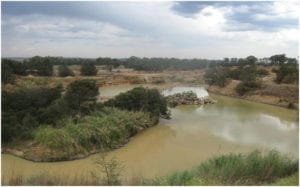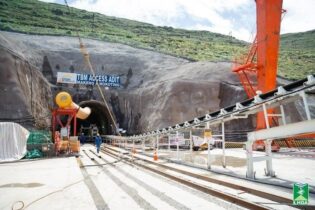Interwaste Environmental Solution’s FG Landfill Site in Olifanstfontein, Gauteng, is setting the standard by being the first class B liner landfill in South Africa, pre-empting even the new draft regulations liner requirements for a class B site, Interwaste director: Landfill Division, Leon Grobbelaar, tells Chantelle van Schalkwyk.
“A class B landfill is more effective in containing leachate than a GMB liner system, and is the better option in relation to managing leakage and groundwater,” explains Grobbelaar. Interwaste purchased and took over operation of the Frik Groenewald landfill in 2008, after which the name was changed to the FG Landfill and new operation and development plans were compiled and rolledout. These were approached in a phased manner for the 32-hectare site, with Phase 1 being the cell that was already in operation at handover, while construction on Phase 2 commenced in November 2010. Phase 4 is currently under construction, with construction on Phase 3 set to start in three years’ time. Specific to the development plans is the liner design for Phase 2 of the site, which is based on the new Draft National Standards for Waste Disposal to Landfill in relation to a containment barrier for a Class B site. This design is not only in line with current minimum requirements, but is also the first to be developed in accordance with the new containment barrier system, pre-empting the new requirements. As Grobbelaar notes, various combinations of specific materials were tested for suitability in the composite liner before the contractor, Gundle Geosynthetics, and the Interwaste team decided on the final design. Some highlights of the landfill liner composition include a 150mm stone leachate collection layer, a 150mm under drainage and monitoring layer, a geosynthetic clay liner and the fact that geotextile has been wrapped around the stone drain in which the perforated HDPE leachate collection pipes are located. Landfill cell development Phase 2 of the project commenced in November 2010.A number of challenges were faced onsite, not least of which was a daunting amount of silt that had to be removed. “These high silt volumes were never anticipated,” says Grobbelaar. The team pumped silt for approximately 180 days with 4- and 6-inch pumps. The silt amounted to 22 000 cubic metres, mixed and excavated, at an average cost of R35per cubic metre. Grobbelaar adds that other challenges included rock layers of up to 2m thick encountered over 60percent of the excavation area, as well as securing high volumes of suitable stone with the correct engineering characteristics for the composite liner. The quantity of stone required totalled 10 750 cubic metres, with 5 000 metres of drainage pipes necessitated for under-drainage and leachate collection systems. As part of the Phase 2 design, a leachate pond was also incorporated with the capacity to handle 1 in 50year floods. Another unique aspect of the cell development project, this time at the start of construction on Phase 4 of the landfill, was the relocation of almost 2 730 fish located in the onsite water bodies to bigger, more appropriately located dams in the area after having gone through an adaptation phase. Once completed, the entire FG Landfill facility will have approximately 4.5 million cubic metres of airspace. Phase 4 will be the biggest cell with approximately 1.3 million cubic metres of airspace available once completed. Phase 1 has 900 000 cub metres of airspace, Phase 2, 1 millioncubit meters of airspace and Phase 3, the final phase, for which construction is set to commence in 2015/2016, will have a projected 700 000 cubic metres of airpsace available. Although this is a total of 3.9 million cubic metres, the 4.5 million cubic metres of total airspace quoted has also taken into account settlement over the years, explains Grobbelaar.Peak performance
The FG Landfill site is well situated between the three Gauteng metropolitan municipalities, namely the City of Johannesburg, the City of Tshwane and Ekurhuleni Metropolitan Municipality. “This means we are ideally situated to service these communities, with the location allowing for cheaper transport costs,” comments Grobbelaar. Currently, both Ekurhuleni and the City of Johannesburg waste management contractor, Pikitup, are using the facility. “Though we started by receicing on average 3 000 tonnes of waste per month, by June 2013 we were receiving 49 000 tonnes per month,” he says. These tonnages are facilitated by not only the innovative design, but also the team and technology located onsite. The FG Landfill is equipped with three weighbridges that use the latest weighbridge software which is integrated into the waste information system and which has specifically been designed for Interwaste. “This system captures, records and photographs every transaction,” explains Grobbelaar. On average the facility receives 1 900 tonnes of waste per day, which means the weighbridges process an average of 7 200 transactions monthly. Other equipment onsite includes two landfill compactors, one bulldozer, one excavator, an articulated dump truck and a water trailer. The waste accepted at the FG Landfill is predominantly domestic, with a limited amount of delisted industrial waste. This is facilitated by the fact that the site is equipped with its own laboratory to perform the required confirmation testing on arrival. The site is also currently undergoing a NOSA star grading, with a four star grading expected. “An ISO 18001 accrediation process is also nearing finalisation,” says Grobbelaar, adding that this is indicative of safety being “the order of the day”. Currently, there are 40 personnel onsite who regularly undergo, not only safety training, but also ABET and operator training. Permit conditions prohibit reclaimers onsite. Compliance with this requirement is ensured through a 2m high primary concrete fence around the main site, with the entire buffer zone being fenced off with another 2m high palisade fence. Facing forward Grobbelaar notes that in a changing waste landscape where eventually we could see waste being banned from disposal to landfill, it is important to be current and stay ahead of the game. However, waste to landfill is still the predominant means of managing waste. In light of the the dwindling airspace available at local landfill sites, Interwaste has recently licensed a brand new facility in Delmas, Mpumalanga, with a total footprint of 350 hectares. “This site has a projected lifespan of 102 years and ensures that once the FG Landfillis full, which will be in about 2020/2021, we will have another facility already established,” concludes Grobbelaar.







